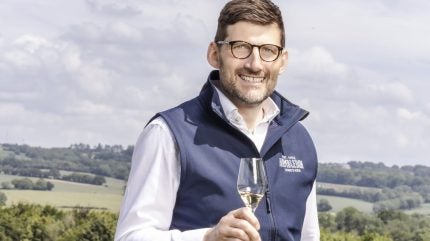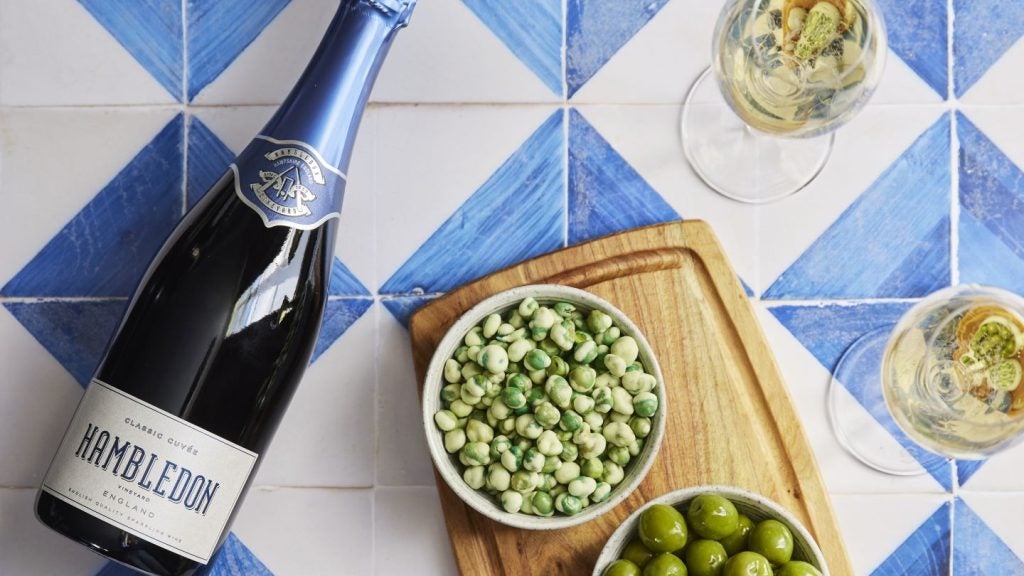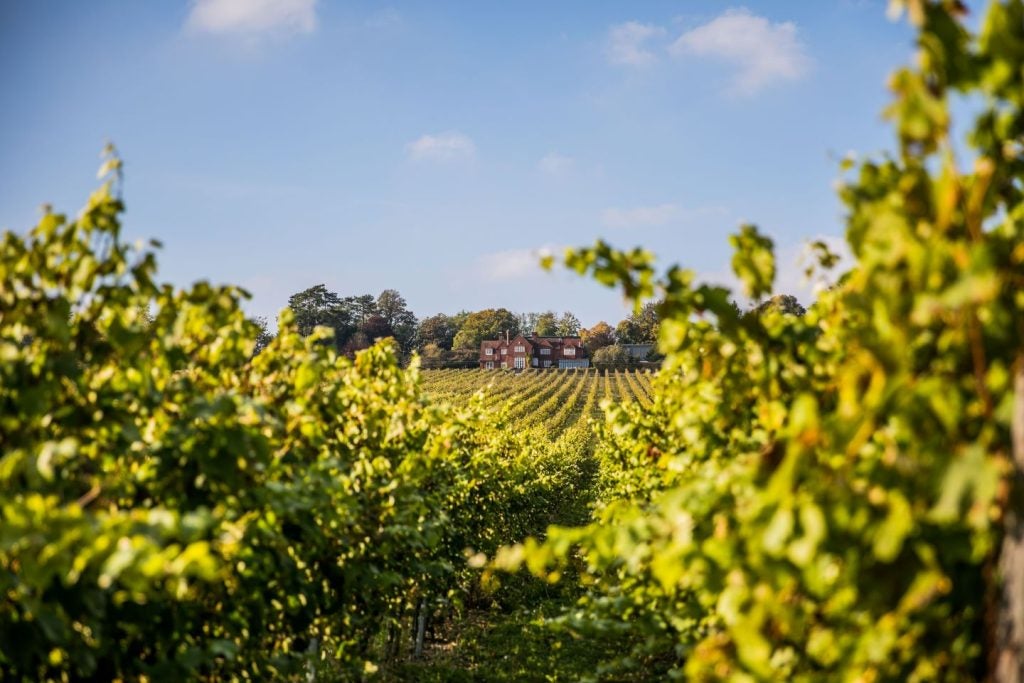
Founded in 1952, the UK’s Hambledon Wine Estate is one of the earliest entrants in English wine, owning one of the oldest commercial vineyards in the country.
Based in England’s South Downs, the sparkling winemaker was snapped up by Portugal’s Symington Group and UK fine wine retailer Berry Bros. & Rudd in 2023 for a £22.3m (then $27.3m) sum.

Discover B2B Marketing That Performs
Combine business intelligence and editorial excellence to reach engaged professionals across 36 leading media platforms.
The next year, Hambledon’s new owners appointed James Osborn as managing director. He had previously worked for global retail consultancy Knight Frank.
Two years into the role, Osborn is looking to three pillars to build the business: UK trade, global exports and its own hospitality at its 200-acre vineyard. At home, the vintner’s sparkling portfolio is sold in retailers such as Waitrose and its owner, Berry Bros. & Rudd, while internationally, it’s available in the US, Japan and Norway.
Just Drinks sat down with Osborn to discuss his three-pronged growth plan, and where he thinks the English wine category is headed next.
Fiona Holland (FH): What is your general opinion on English wine at the moment?
James Osborn (JO): There is a real belief in the industry. We’re starting to see that translate through to the buyers in what’s being produced across the country in terms of the quality, and that partly comes from the quality of the fruit improving, partly through the winemakers coming into the industry, and partly through people looking to experiment.

US Tariffs are shifting - will you react or anticipate?
Don’t let policy changes catch you off guard. Stay proactive with real-time data and expert analysis.
By GlobalDataBelief and confidence is the big change that I’m seeing compared to where I was probably 10 years ago in the industry when I first came into it.
FH: Is it a good time to be in English wine? English is still at a very different stage obviously to other wine regions.
JO: I’ve been doing a lot of traveling in the last six months. English is very interesting to people, and that’s at every level, from [sommeliers] to buyers representing groups to influencers globally. They’re just really intrigued… We can capitalise on that.
Then when they taste the liquid, and they understand more about the winemaking process and understand more about the characters behind making it. It’s all those pieces come together to form a really strong proposition.
FH: When you say “interesting”, is that in terms of English being a different region to what has been available in the past?
JO: Where your wine is made matters more than ever. So having a brand and an experience that can engage multiple generations is important.
When we talk about Hambledon, we talk about when they visit us. They don’t just taste the wine. They walk in our founders’ footsteps, Sir Guy Salisbury-Jones. They connect with likeminded people, they create memories. They go away and they talk about it with their friends and their family, and they become our greatest ambassadors. Place is becoming more important and more interesting than just the liquid in the bottle.
FH: Some wineries have seen higher supply than demand. Are there still a lot of consumers that don’t know about English wine?
JO: We’re seeing, in the UK trade, a lot of new entrants. You still see the market leaders, but there’s more choice than ever before. The category challenge is investing in short-term sales activation, as well as in long-term brand-building and brand growth. To be successful, you need both, but to do both, you need money to invest. That becomes hard when [in] the UK trade, the margins are being squeezed, it’s more competitive, and many producers are following the traditional method to make their wines.
What’s going to cut through? It’s brand. For me, where people can win, where people can create growth, is rather than when you’ve got a saturated market with wine, it isn’t about more volume, it’s about more value. That’s about focusing on building a brand that people seek out by name that’s just not another label on the shelf. Ultimately, what we want to do is be recognisable. We want to be a desired brand that deserves a place alongside Champagne in the homes of consumers.

FH: What main growth ambitions do you have for Hambledon in the next 12 months?
JO: We want to move away from a reliance on UK trade. That’s not to say completely ignore it and completely exit it, but we’re seeing quite an aggressive market, tight margins with limited brand visibility. For us to be able to treble the size of our business, which is what we want to do in the next five years, is that it’s about building three pillars from which we can grow Hambledon.
In effect, those three pillars are our own hospitality, so we’re investing a lot in that, UK wine trade, but also international. They become three levers that I can pull, so if one particular element isn’t doing as well as another, or there’s more of a short-term opportunity with one, I can pull that lever to make the most of that market opportunity. It means that we have to be agile as well.
My goal is a third of our investment is in own hospitality, a third is in UK wine trade, a third is in international business. If we get that right, I think it puts us in a really strong position to adapt to the challenges that the market throws at us, and it helps de-risk the business, rather than being over reliant, which I think a lot of the UK wine market is on the UK trade.
FH: Which international markets are you in? Are there any new ones you’re looking to move into in the next year?
JO: Some markets are more advanced than others where we are.
Norway is leading the charge internationally for English sparkling wine. Particularly with the appetite that Norwegians have for the profile of English sparkling wine; slightly fresher style, pairs very well with their food. There’s a lot of activity, a lot of English brands in the market. Scandi markets, I’d say, [are areas] where we’re looking to develop, apart from Norway.
Southeast Asia is another. Again, we’re seeing the profile of English sparkling wine lands pretty well in certain regions where it’s pairing really well with food, those food styles, it connects really well with culture. For us, we’ve got a really strong English heritage, so when it comes to talking about our ‘Englishness’, then I think we do have a competitive advantage in the market.
Then the USA is the third region, and we’re seeing a lot of interest in English at the moment. The turmoil with tariffs is probably feeding into that, partly because of the uncertainty around what’s going to happen in Europe with Champagne, and the goalpost keeps shifting, and I think that uncertainty is playing to our advantage.
Buyers who want to make sure that they have supplies, good supplies of stock going through their high season can rely on a brand or a category where there’s not going to be price fluctuation or changes in supply, or uncertainty in supply. Although we do have a tariff at 10%, we’re pretty locked into that now, whereas with Champagne in Europe, there’s still that uncertainty, I think it’s beginning of July where there’s a hard stop to make a decision.
FH: Where in the US are you currently available?
JO: We’re focused on East Coast, but it will be the whole of America at some point. That’s our plan.
FH: And in Southeast Asia, are you currently sold there?
JO: We’re in Japan, and we have been there for a while. Berry Bros. & Rudd represent us… Japan needs to charge for us in Southeast Asia, but we’re exploring other markets. We’re not sure where those priorities are for us at the moment, but we’re meeting with importers and just working through a priority list.
English wine, it’s quite an exciting thing for the international markets. My caveat to all of this is that English wine won’t scale internationally until we build brands with emotional and cultural relevance.
Our ambition is to be a great wine estate, but also to be a defining part of English wine’s identity on that global stage. We’re not going to win on our own, we’re going to win together, and WineGB are investing a lot of time and effort in opening doors, working with the Department for Trade to make sure that brand ‘English’ is in front of the right people in the right markets.
English wine won’t scale internationally until we build brands with emotional and cultural relevance.
FH: What do you mean by having “emotional and cultural relevance”?
JO: It comes back to what I said earlier about there’s too many labels in the market. There’s not enough brands.
You’ve got to be distinct. You’ve got to invest in storytelling, you’ve got to build strong partnerships [with] likeminded brands, not necessarily in English wine sector, to help build your profile.
Being distinct is really important, and that’s not necessarily about coming to the market with a really strong creative campaign to engage people to do your storytelling for you. That’s important, but it’s about making sure that you’re consistent in what you do and what you say. It’s connected to what makes you special in the wine market.
Then it starts to have relevance to your consumer. It starts to have cultural relevance. It creates standout on-shelf, and that that comes down to the assets that represent your brand, be it the bottle, be it your label.
I’m not saying we’re doing it absolutely right and that we’re a shining example, but that’s a big project that we’re working on at the moment to make sure we are in future.
FH: What challenges does English wine still have to overcome?
JO: We have a challenge with our PDO (Protected Designation of Origin) … I think what we’re starting to see is bulk wine coming into the UK. That bulk wine in tank is then being blended in with fruit from maybe an English vineyard, or it’s just being used to make the sparkling wine.
The packaging for that looks like it comes from a beautiful part of England, and the price point is quite aggressive, and there’s a bit of smoke and mirrors going on because they put it’s ‘made in England’ on the front. The consumer looks at that, and they’re none the wiser to the next bottle, which says ‘quality English sparkling wine’, which is made using the traditional method from fruit grown in an English vineyard, and it’s part of the PDO. The consumer can’t discern from that.
Having ‘England’ in that PDO is a really key thing, which I know WineGB are working hard to do.
A reliance on UK trade for a lot of my peers is a challenge. If it’s not about, for them, creating a brand, I think it’s about derisking their business, and it’s about investing in international, it’s trying to invest in their own hospitality, which I know is easier said than done, and it requires, again, more investment, more capex, to do that.
We’re a winemaker… but we’re actually in the business of hospitality. It’s about giving people through dining, so through our restaurants, through the experiences that we’re creating a memorable, immersive connection to brand Hambledon, and it’s turning our vineyard into a destination that’s as memorable as the wine itself.
That’s a challenge for a lot of my peers. It’s how can they do that really well? Take advantage of the surge in wine tourism that we’re seeing. Take advantage of direct-to-consumer sales, cellar sales where there’s better margin, where they’ve got more control over brand, where they can secure more members.

FH: You mentioned selling D2C. What are the main channels that you sell through?
JO: We have a fantastic partnership with Virgin Atlantic, and that has lasted for many years… and it’s a powerful way to build visibility for brand Hambledon and create a deeper emotional connection with a global audience.
UK trade is a really important channel, and we see ourselves across a number of restaurant listings, and we see ourselves in the off-trade as well. We’ve had a good start to the year by being with The Pig [hotels]… UK really [is] key, but we’re looking to now grow our international business, that’s a big focus for us, and to grow our own hospitality sales.
FH: Globally, are you targeting on-trade/off-trade?
JO: It’s a combination of, and depending on the importer we’re working with and the distributors we’re working with, so where their specialisms lie, but also with the state of the market, where the greater opportunity is. We’re quite agile in that respect. There’s a slightly different model for each region and then for each market within each region.
FH: Do you plan on adding still wines to the portfolio?
JO: Still is where Hambledon started back in 1952 and I’m keen to look at what we can achieve with still.
It will never be the lead. It will never be 50% of the business, but it will be interesting to see what we can achieve here, and if nothing else, for us to be able to pour a still English rose made from the fruit that people can see on the vines in front of them when they’re sitting on our terrace one evening in the beautiful South Downs national park, that’s made here rather than bringing in still rose from another part of the world.
Commercially, it makes more sense for us to do that through our own channel, through our own hospitality. I’m quite interested to see what we can do, but for us, first and foremost, it’s about being an excellent sparkling wine estate in the English wine world, where we are committed





